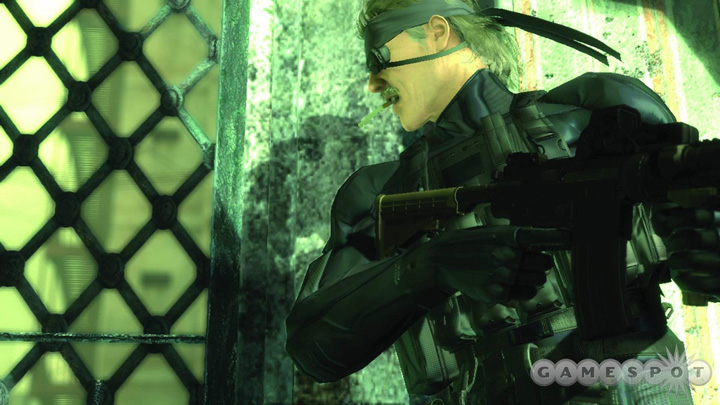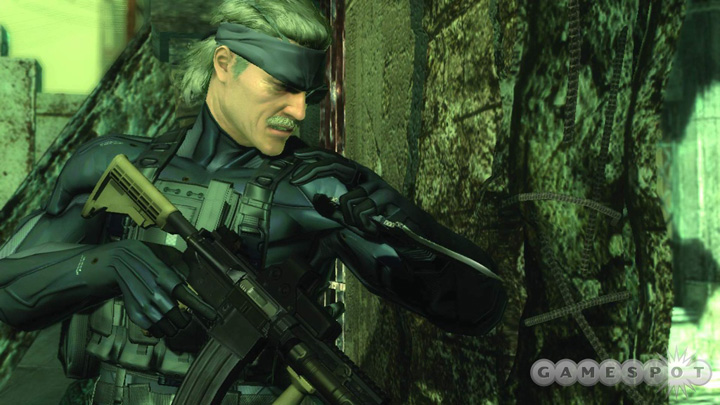PlayStation 3 Next-Gen Audio
We talk with Metal Gear Solid 4 sound designer Sotaro Tojima about PlayStation 3 audio and what we can look forward to in Snake's next adventure.
You can easily point to graphical quality if you want to demonstrate how gaming gets better and better. Look at a screenshot of Pong and then peer over at one of Gran Turismo - you likely won't hear any arguments about which one looks better. In the face of pretty textures and 1080p resolutions, discussions about sound quality tends to fall by the wayside when a game puts jaw-dropping visuals up on the screen. However, what you hear is just as important as what you see.
Moving from the Atari 2600 to the Nintendo Entertainment System alone brought us out of the bleeping and blooping age and into games filled with music and a variety of sound. The Atari 2600 came with support for a whopping two voices, but the NES upped the ante with five channels, each supporting a set frequency spectrum to create something akin to a fancy tone generator. The Sony PlayStation arrived a few generations later to give us high quality CD audio music and actual voices in games. The Xbox treated us to Dolby Digital surround sound rendered in-game. On the fly surround-sound encoding brought gaming one step closer to replicating the hallowed movie standard.
However, when it comes to game audio, technical quality can easily lag behind intrinsic quality. You don't always need the best hardware to carry a catchy tune. The soundtrack to Super Mario Bros easily proves we don't need reference-quality music or fully orchestral scores for all games. The technical merits of the score would rank quite low, but for sheer fun and appropriateness, the soundtrack stands out and is one that gamers still remember quite fondly. Cartoon-like games might get away with a technically simple score, but as graphics get more complex and lifelike, the sounds within those games have to keep up too. God of War's grandiose soundtrack wouldn't have sounded nearly as good if the developers only had the audio range of the NES to work with. We checked in with Konami's sound director for the highly anticipated PS3 game Metal Gear Solid 4 for more details on what we can expect from next-gen audio.
PlayStation 3 Audio
Next-gen consoles like the PlayStation 3 make considerable inroads into improving what goes into your ears. The PS3 will be able to run up to 512 different voices, and apply different sound layers onto them depending on what the developer wishes. More voices means more concurrent sounds--like background music, cars screeching, crashing, guns shooting, and people talking. More layers means more ways to filter the sound. For example, the developer can change the sound of a gunshot to fit into a cave-like environment. The PS3 will support up to eight channels of audio, or 7.1, running at 96KBs per channel. Reduced-channel formats, like Dolby Digital 5.1, will have higher bit-rate audio streams. We've had 5.1 surround sound since the last generation of games, but expect more games to take advantage of the virtualization features with better sound placement.
| PlayStation | PlayStation 2 | PlayStation 3 | |
| Audio Processor | SPU | SPU2+CPU | Cell SPE |
| Number of Voices | 24 | 48 | 512 |
| Sampling Frequency | 44.1kHz | 44.1/48 kHz | 44.1/48 kHz |
| Sound Formats | Stereo | Stereo/DTS | Stereo/Dolby Digital/DTS |
| Sound Memory | 512KB | 2MB | 0-256MB(shared system memory) |
The Cell processor's Synergistic Processing Elements (SPEs) will take care of the audio-processing needs in the PlayStation 3, but developers will have to be careful about balancing system resources since many other game functions also run through the Cell. According to Sotaro Tojima, sound director for Metal Gear Solid 4, "There's no hiding the fact that [the Cell] will have to handle many duties including graphics, AI, and sound." Developers will have to make compromises. There is, after all, a finite amount of processing power. With respect to Metal Gear Solid 4, Tojima mentions that "The MGS team is currently surveying the right balance for all of this. A major priority for the team is to delegate a very generous amount of processing power to sound quality."
Each SPE on the Cell processor consists of 21 million transistors, two thirds of which is dedicated to SRAM, leaving seven million transistors for logic. SRAM acts as a small data cache and the logic portion performs all the calculations. In comparison, Creative's new X-Fi sound processor has 51 million transistors, and its previous chip, the Audigy, had 4.6 million transistors.
The PS3 will store audio on shared system memory, so sound files will have to compete for space with other files relating to running the game. Tojima's team "has a knack for 'cheating' or figuring out clever ways to squeeze out a lot of sound quality." The team managed to make an excellent-sounding backdrop for Metal Gear Solid 3 on the PlayStation 2, despite being limited to a relatively small amount of processing power and sound memory.
Tojima explains that limited storage space can degrade sound quality because developers are forced to use poor sound effects to save space. Tojima points out that, "Until now, the sound for in-game cinematics has been quite good. However, sound quality tends to take a hit when the player takes over and begins to play the game." We've seen this time and again on the PlayStation 2. Cinematic cutscenes playback with full surround sound and increased bit rates, but once the action starts, the music and sound all play second fiddle to a real-time graphics engine, with in-game audio generally dropping down to two-channel stereo.
Snake Goes Surround
That's all going to change on the PlayStation 3. "With next-generation consoles, both cinematics and in-game sound will closely resemble those found in Hollywood films," according to Tojima. He fully expects gamers to "be surprised by the quality of sound coming into their ears--the sound will react to their conditions in the 3D world like never before." For example, in the scenario where a bottle falls off a table, hits a metal shovel, and then rolls onto a carpet, conventional sound processing would have the bottle make the same sounds regardless of the environment, or what it collides with. That same scenario on the PlayStation 3 might have the bottle make a metallic tink when it hits the shovel, and then create a muffled rolling sound as it travels across the carpet. If the room had its own sound variables, the bottles sound might get take on some echo if in a bathroom, or get slightly quieter if in a bedroom. Then you have to factor in on-the-fly surround encoding, which would make the bottle pan from front to back or side to side in your room, depending upon the way it rolled.
The Metal Gear Solid team flew around the world to capture specific sounds for environments in the game. The group actually lugged surround-sound audio-recording equipment to capture sounds from undisclosed locations all around the world. Tojima's team also recorded special sound effects just for the game, instead of using prerecorded, CD-based sounds.
The new audio-processing capabilities of the PlayStation 3 allow Tojima and his team to manipulate sound in a variety of different ways. Tojima says that, "With this power, we can give the player a better environment to experience, as the hardware can produce more sounds in real time based on where the player is in a room and what objects are in that room." Last year's Tokyo Game Show trailer emphasized the theme "No place to hide!" and Tojima, as sound director, will do all he can to envelop the player in the world of Metal Gear Solid. "In a battlefield with no place to hide, you will hear impending dangers all around you, in all 360 degrees."
You'll need to have surround-sound support to get the most our of next-gen audio. Add a 7.1 or 5.1 surround system right beneath that HDTV on your next-gen preparation shopping list. The difference between stereo and 5.1 sound is readily noticeable to most people as the sounds coming from a subwoofer and rear speakers are hard to miss. A jump from 5.1 to 7.1 is a bit more subtle since you're basically only adding two additional speakers to an existing surround setup. Home theater in a box setups (HTIBs) start as low as $200. Consider picking up a set if you plan on getting a PlayStation 3 and Metal Gear Solid 4.
Got a news tip or want to contact us directly? Email news@gamespot.com


Join the conversation